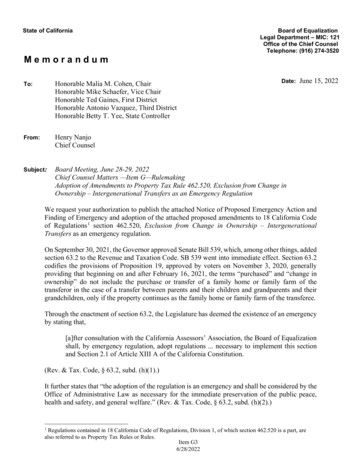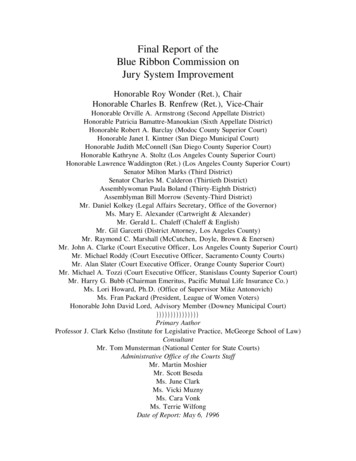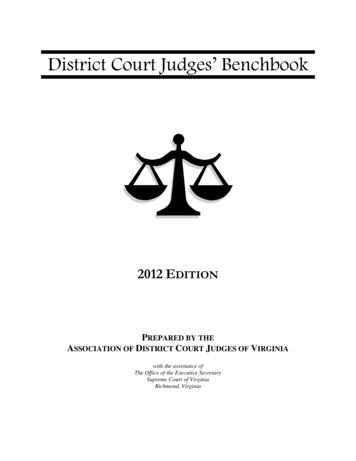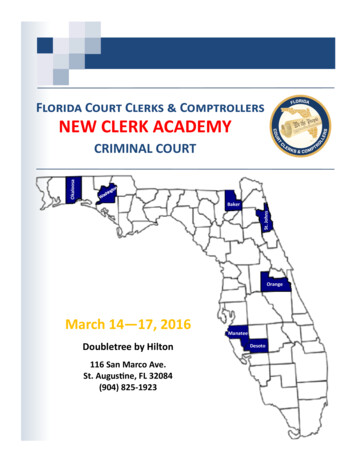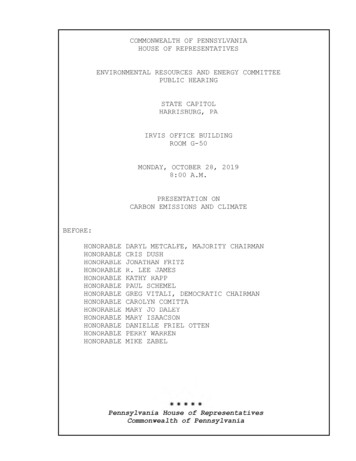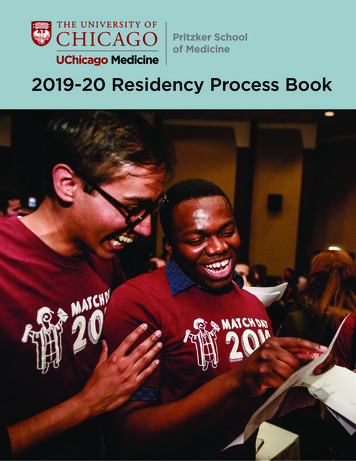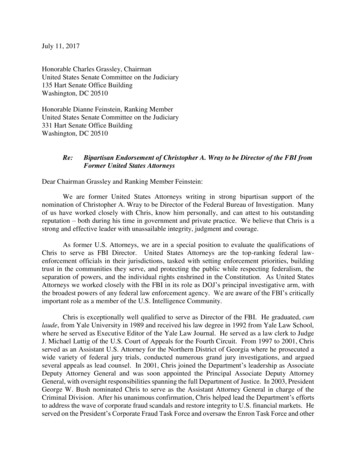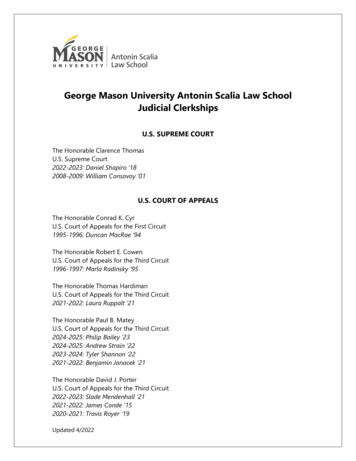
Transcription
To the Honorable JB Pritzker, Governorand Members of the General Assembly:This report provides details on opioid overdoses in Illinois for the year 2020. Overdose data from the previousyears are also provided to allow for comparisons. The Opioid Overdose Semiannual Report consolidates the overdosereporting requirements under the Hospital Licensing Act (210 ILCD 85/6.14g) and the Counties Code (55 ILCS 5/3-3013).The report includes information on overdose deaths, including heroin and opioid analgesics. Additionally, itincludes non-fatal overdose information reported by hospitals to the Illinois Department of Public Health (IDPH) asrequired in the Hospital Licensing Act (210 ILCS 85/6.14g(b)). This semiannual report updates the “Opioid OverdoseSemiannual Report - September 2020”, adding more recent data and trends. The 2020 data shared within this reportare finalized.In 2020, opioid overdose deaths among Illinois residents increased 32.7% from 2,219 deaths in 2019 to 2,944deaths in 2020. The report includes demographic data that indicate a continuation of the previously reported racialdisparities, with non-Hispanic Black or African American populations continuing to be disproportionally affected byopioids.Continuing reporting, updates, and information may be found on the IDPH website athttp://dph.illinois.gov/opioids/home and https://idph.illinois.gov/OpioidDataDashboard/. Among the many resourceson the IDPH website are the Illinois Opioid Action Plan and the Illinois Opioid Action Plan Implementation Report, whichare located under “Data and Reporting” and “Publications.”I hope you find this report informative and useful as we continue working together to address the opioid crisisfacing Illinois.Sincerely,Ngozi O. Ezike, MDDirector
Statewide Semiannual Opioid ReportIllinois Department of Public HealthAugust 2021FATAL O PIOID O VERDOSESIn 2020, there were 2,944 fatalities due to opioid overdose in Illinois, an average of eight Illinoisresident deaths per day. This represents a 32.7% increase from 2019 (Fig. 1) and is 2.3 times higher thanmotor vehicle fatalities and 2.2 times higher than homicides. While the number of fatalities has been steadilyincreasing since 2013, 2020 was the largest annual increase over this time.Prior to May of 2020, the monthly trends fluctuated, but overall, overdose incidents were gradually onthe rise. The rate of increase began to escalate in the second half of 2019 and culminated in May 2020 with apeak of 354 deaths. The number of deaths decreased in the following months (June – Dec.; Fig. 2).Yearly Opioid Fatalities in Illinois2013-20203,5002,9443,000Number of 0Figure 1. Yearly opioid fatalities in Illinois from 2013-2020 as reported by the Illinois Vital Records System,IDPH.
Monthly Opioid Fatalities in Illinois2018-2020400350Number of gure 2. Monthly opioid fatalities in Illinois from 2018-2020 as reported by the Illinois Vital Records System,IDPH.
Demographics of opioid fatalities are listed in Table 1. The highest number of opioid fatalities in 2020occurred in non-Hispanic White individuals (1,530), while the highest fatality rate was among non-HispanicBlacks (55.3 per 100,000). By age group, the highest number and rate of opioid fatalities occurred in the 35–44-year age group (686; 41.8 per 100,000), followed by the 45-54-year age group (683; 41.7 per 100,000).Finally, the highest number and rate of opioid fatalities occurred in males (2,167; 34.6 per 100,000), whichaccounted for 74% of the fatalities.Table 1. Statewide opioid fatality rate by race/ethnicity, age group, and sex for 2020 as reported by the IllinoisVital Records System, IDPHTotal NumberFatality Rate (per100,000 of eachpopulation)153010443442620.855.3163.1 2525 - 3435 - 4445 - 5455 - 6465 777216712.034.6Race/Ethnicity*Non-Hispanic WhiteNon-Hispanic BlackHispanic/LatinxNon-Hispanic OtherAge GroupsSex*The fatality rate for race/ethnicity is age-adjusted.Synthetic opioids, specifically fentanyl, are the leading cause of fatal drug overdoses statewide and areinvolved in 84% of opioid fatalities and 70% of all drug fatalities in 2020. However, the substance uselandscape across the state is different depending on location. There are pockets of high opioid overdose ratesin both urban and rural areas, with 15 having a rate above the statewide opioid fatality rate of 23 deaths per100,000 capita. Figure 3 and Table 2 depict the county-level opioid overdose fatality rate per 100,000 capita.
2020 Illinois Opioid Fatality Rate per 100,000 CapitaFigure 3. 2020 Illinois opioid fatality rate per 100,000 capita by county as reported by the Illinois Vital RecordsSystem, IDPH. County-level fatality rates are calculated by the number of county residents who died due toopioid overdose per year divided by the population of the county and multiplied by 100,000. Counties withsmaller populations could have rates higher than counties with larger populations, even though there arefewer opioid fatalities.
Table 2. 2020 Illinois opioid fatality rate per 100,000 capita by lesCookCrawfordCumberlandDeKalbDe rdinHendersonHenryIroquoisOpioidFatality Rateper ntyJacksonJasperJeffersonJerseyJo DaviessJohnsonKaneKankakeeKendallKnoxLakeLa PerryPiattPikePopeOpioidFatality Rateper 023.7CountyPulaskiPutnamRandolphRichlandRock IslandSt. oidFatality Rateper 87.8
Non-Fatal Opioid OverdosesMonthly Opioid Overdose-Related ED Visits and EMS Encounters inIllinois, 20202500Number of gSepOctNovDecEMSFigure 4. Monthly opioid overdose-related emergency department (ED) visits and emergency medical services(EMS) encounters in Illinois in 2020. ED visits as reported by IDPH Hospital Discharge Dataset; EMS encountersas reported by IDPH Prehospital Emergency Medical Services.Monthly Opioid Overdose-Related Hospitalizations in Illinois, 2020Number of unJulAugSepOctNovDecFigure 5. Monthly opioid overdose-related hospitalizations in Illinois in 2020 as reported by IDPH HospitalDischarge Dataset.
Monthly opioid overdose-related ED visits and EMS encounters in 2020 peaked during the spring and summermonths and then decreased in the autumn and winter months (Fig. 4), which was similar to the fatal overdose trends.Hospitalizations for opioid-overdose related conditions followed a similar trajectory, peaking in July 2020 and generallydecreasing across the autumn and winter months with a slight increase in December (Fig. 5). Throughout 2020, Illinoisexperienced the opioid overdose epidemic and the COVID-19 pandemic. For more detailed information on the impact ofCOVID-19 on the opioid overdose crisis, visit http://www.dph.illinois.gov/opioids/idphdata.
This report provides details on opioid overdoses in Illinois for the year 2020. Overdose data from the previous years are also provided to allow for comparisons. The Opioid Overdose Semiannual Report consolidates the overdose reporting requirements under the Hospital Licensing Act (210 ILCD 85/6.14g) and the Counties Code (55 ILCS 5/3-3013).


